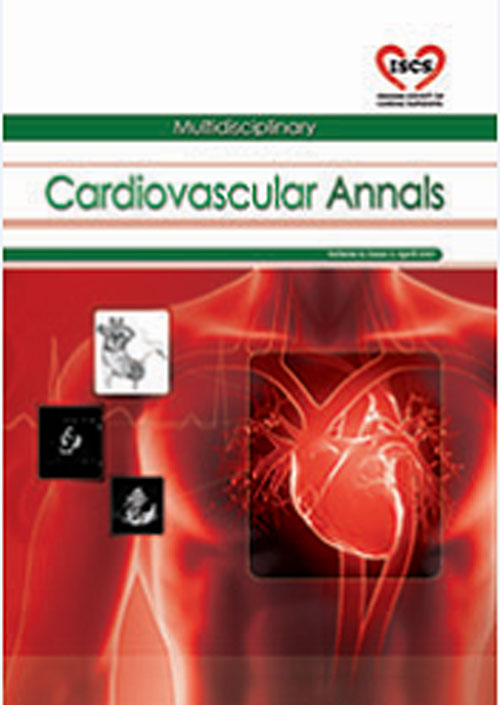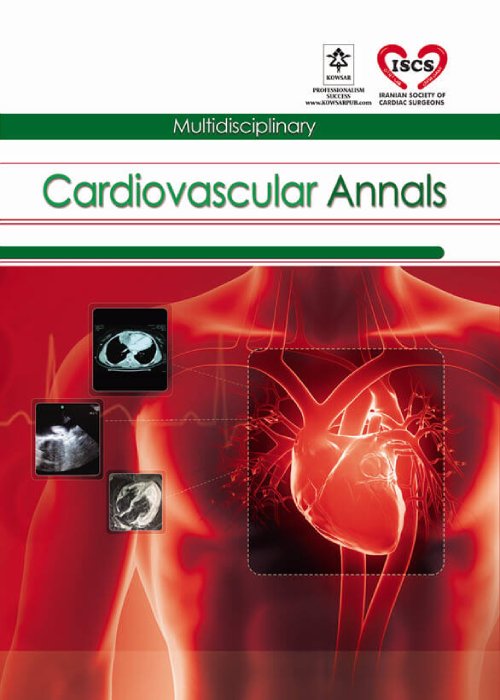فهرست مطالب

Multidisciplinary Cardiovascular Annals
Volume:10 Issue: 2, Jul 2019
- تاریخ انتشار: 1398/07/07
- تعداد عناوین: 8
-
-
Page 1Background
Obstructive sleep apnea syndrome (OSAS) is the most common respiratory disorder related to sleep. It is characterized by recurrent upper airway obstruction episodes and a decrease in arterial oxygen saturation during sleep. The most important complications of OSAS are related to the cardiovascular system. Hypertension (30% - 60%) is the leading cause of these complications.
ObjectivesThis study aimed to investigate the removal of upper airway obstruction through surgical operations in the tension treatment of OSAS patients with hypertension.
MethodsThis retrospective study included 42 patients with hypertension from 2008 to 2017 who were diagnosed with OSAS based on the result of polysomnogram (PSG) test. All the patients were examined in detail in otorhinolaryngology and cardiology clinics, their endoscopic and imaging evaluations were carried out and their blood pressure was followed-up. Preoperative and postoperative arterial blood pressure values for upper airway obstruction were statistically analyzed.
ResultsThe mean preoperative systolic and diastolic arterial blood pressure values of the patients with hypertension were 152.3 ± 21.2 and 97.2 ± 12.3 mmHg, respectively. Their postoperative systolic and diastolic arterial blood pressure levels were found to be 124.5 ± 19.3 and 86.4 ± 12.1 mmHg, respectively (P < 0.05). This decrease in the arterial blood pressure was significant.
ConclusionsRemoval of upper airway obstruction through a surgical operation was found to play an important role in the blood pressure treatment of OSAS patients with hypertension.
Keywords: Obstructive Sleep Apnea Syndrome, Cardiovascular, Uvulopalatofarengoplasti, Hypertension -
Page 2Background
Hypokinetic non-dilated cardiomyopathy (HNDC) is a subgroup of dilated cardiomyopathy (DCM) spectrum, known by left ventricular (LV) systolic dysfunction despite normal LV size.
ObjectivesIn this study, we are going to evaluate right ventricular (RV) function in these patients as an important prognostic factor in HF patients.
Methods31 HNDC patients were enrolled in the study. RV function was evaluated by TTE using RV dysfunction score calculated as the summation of TAPSE, RV S’, RVMPI, and RVFAC scores. Ultimately, echocardiographic data were compared to right ventricular ejection fraction (RVEF) obtained from cardiac magnetic resonance imaging (CMR).
ResultsThe prevalence of RV at dysfunction was estimated at 47.3%. Furthermore, we found a strong negative correlation between RV dysfunction score and CMR-RVEF.
ConclusionsRV S’, RVFAC, and RVMPI would offer an appropriate assessment of RV function in HNDC group. HNDC population exhibited RV dysfunction as prevalent as DCM patients reported in other studies.
Keywords: HNDC (Hypokinetic Non-Dilated Cardiomyopathy), CMR (Cardiac Magnetic Resonance Imaging), RV Function (RightVentricular Function), Echocardiography -
Page 3Background
Pulmonary hypertension is a rare and fatal disease and several methods are available for its risk stratification. Right heart catheterization is gold standard tool for this target but this method is invasive and expensive. Serum uric acid level is a controversial method for this aim.
ObjectivesThis paper aims to discover a correlation between serum uric acid level and severity of pulmonary hypertension based on right heart catheterization.
MethodsUric acid level was measured in 128 pulmonary hypertension patients who had undergone right heart catheterization. Then, the correlations between uric acid level and right heart catheterization findings as well as pulmonary hypertension severity were assessed.
ResultsThe correlations between serum uric acid level and CI (P = 0.019), DAP (P = 0.032), MAP (P = 0.027), RAP (P = 0.002), SPAP (P = 0.015), MPAP (P = 0.035), PPPA (P = 0.011), SO2S (P = 0.005), MVO2S (P = 0.004) are significant. A positive correlation was found between serum uric acid level and pulmonary hypertension risk based on RAP (P = 0.006) and MVO2S (P = 0.022).
ConclusionsIt was found that the serum uric acid level is significantly correlated with some parameters of right heart catheterization including CI, DAP, MAP, SPAP, MPAP, PPPA, especially RAP, SO2S and MVO2S. Also uric acid level is significantly correlated with severity of pulmonary hypertension based on RAP and MVO2S and the level is increased in high risk ranked patients.
Keywords: Uric Acid, Pulmonary Hypertension, Right Heart Catheterization, Prognosis -
Page 6Background
This randomized clinical trial was carried out so as to discover the efficacy of both ɛ-aminocaproic acid (Caproamin Fides®) and tranexamic acid (Transamin®) among high risk patients in primary coronary artery bypass grafting surgery.
MethodsFrom December 2010 to January 2013, 100 consecutive high-risk adult patients undergoing CABG at Rajaie Cardiovascular Medical & Research Center, Tehran, Iran were included in this randomized double-blinded study. Patients who had a past history of, coagulation disorders and allergy reactions to both Caproamin Fides® and Transamin® were excluded. One group of patients received 150 mg/kg Caproamin Fides at the beginning of surgical incision and an additional 1 gr/h during operation (group 1). The second group were administered transamin with a primary dose of 10 mg/kg infusion being coincident with surgical incision (group 2). Then, patients were followed by their blood transfusion volumes, mediastinal bleeding and postoperative complications.
ResultsOne hundred patients as 79 males and 21 females with ages at the mean of 66.4 ± 7 years were enrolled in the study. The mean volumes of chest drainage in group one (416 ± 322 in 24 hours and 681 ± 374 in 48 hours) and group 2 (420 ± 303 in 24 hours and 532 ± 399 in 48 hours). The 56% of patients in Caproamin Fides group and 58% of patients in transamin group received a mean of 1.46 ± 1.06 and 1.65 ± 1.04 units of packed cell respectively. During ICU stay 66% of patients in Caproamin Fides group and 25% of patients in transamin group required additional red blood cell transfusion at the rate of 2.4 ± 1.8 and 1.5 ± 0.6 units. Only 1 patient in transamin group received a pack cell transfusion. There were no significant differences in postoperative major adverse cardiovascular and cerebrovascular events (MACCE) between two groups.
ConclusionsCaproamin Fides and transamin are both safe and effective in postoperative bleeding reduction. They also reduce the need for blood transfusion in high risk patients undergoing CABGs and could be used as an acceptable alternative for aprotinin. Tranexamic acid seems to be more effective regarding the need for blood product transfusion in these patients.
Keywords: Bleeding, Transfusion, Caproamin Fides, Transamin, CABG -
Page 7Introduction
Duchenne muscular dystrophy is an X-linked disease and the carriers are almost asymptomatic but rarely, they may present with muscular and even cardiac manifestations.
Case PresentationThis report presents a 41-year-old female case as a carrier of Duchenne muscular dystrophy who presented at our centre with cardiomyopathy, 2.5 months after delivery. Three differential diagnoses including DCM, postpartum cardiomyopathy and cardiomyopathy due to Duchenne muscular dystrophy were considered for this case. According to findings of patient’s CMR, cardiomyopathy due to Duchenne muscular dystrophy was recognized as the most probable disease in this case.
ConclusionsBased on the undertaken investigations, screening with cardiac MRI and echocardiography is recommended for carriers.
Keywords: Duchenne Muscular Dystrophy, Carrier, Cardiomyopathy, Delivery -
Page 8Introduction
Kawasaki disease (KD) is a systemic vasculitis syndrome usually presented with acute fever which occurs primarily in children younger than 5 years of age. KD has become the most common cause of acquired heart disease in pediatric population in developed countries. Kawasaki disease can damage cardiovascular system including myocarditis, pericarditis, coronary artery aneurysms complicated by thrombotic or stenotic lesions that are at risk of myocardial infarction (MI), congestive heart failure and also sudden cardiac death. The incidence of such complications can be dramatically reduced by early diagnosis and intravenous immunoglobulin (IVIg) therapy and high dose aspirin.
Case PresentationA 25-year-old man with a history of Kawasaki disease 17 years ago presented with anterior ST-segment elevation myocardial infarction (STEMI), left anterior descending artery (LAD) and right coronary artery (RCA) aneurysmal dilation and thrombosis with left ventricle ejection fraction (LVEF) of 25% that underwent coronary artery bypass graft (CABG) surgery and surgical closure of coronary artery aneurysms.
ConclusionsThe surgical management of cardiac disease in Kawasaki patients could be safe and effective.
Keywords: Kawazaki Disease, Vasculitis, Coronary Artery Aneurysm, Coronary Artery Disease


